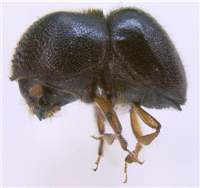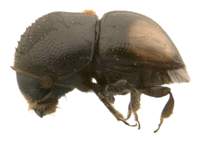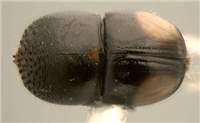Diagnosis
Distinctly stout, compact, pronotum often appear larger than abdomen, almost globular appearance. Pronotum always black, with elevated carina on each side. Elytrae either black or with a pair of large whitish patches. Characteristic tuft of setae on the basis of pronotum associated with mesonotal mycangium, otherwise setae inconspicuous. Antenna club type 1, flat, with first segment completely covering the posterior face.
Number of segments in antennal funicle used to be considered a genus-specific character (Browne 1955, Nobuchi 1983), but the number varies.
Distribution
South Asia and Austronesia. North America recently invaded Cnestus mutilatus (formerly Xylosandrus mutilatus), rapidly spreading.
Biology
Mostly found in the smallest twigs, up to 3 cm in diameter. Some species utilize hollow space in the middle of the twigs for their fungal garden, instead of creating their own cavity.
Taxonomy
Related to Xylosandrus, Anisandrus, and other genera with mesonotal mycangium.
Detailed description
Eyes shallowly emarginate, upper portion of eyes as large as lower part. Antennal club approximately circular, or appears broader than tall, or very flat, club type one (truncated, segment 1 covering posterior side). Segment 1 of club covering entire posterior face, its margin costate. Segment 2 narrow, pubescent or corneous or with small corneous part on anterior side, visible on anterior side only, or visible on both sides of club. Segment 3 absent from or partly visible on posterior side. Segment 1 of antennal funicle shorter than pedicel, funicle 2- or 3- or 4-segmented. Scapus long and slender. Frons above epistoma mostly smooth, alutaceous, with minor punctures. Submentum deeply impressed, shaped as very narrow triangle. Anterior edge of pronotum with two distinct flat denticles protruding anteriad, sometimes whole margin extends anteriad forming distinct "hood" over head. Pronotum from lateral view rarely basic shape (type 0), mostly rounded and robust (type 5). From dorsal view mostly rounded (type 1), sometimes conical (type 0) or conical on anterior part (type 6), rarely basic, short, parallel-sided, rounded frontally (type 2). Pronotal disc shining or smoothly alutaceous, with small punctures, lateral edge of pronotum carinate. Procoxae narrowly separated, prosternal posterocoxal process short and conical, or flat and inconspicuous. Setae on pronotal basis associated with mesonotal mycangium present as small but dense tuft. No setae on elytral bases, no elytral mycangium. Scutellum flat, flush with elytra. Elytral bases straight, with oblique edge, elytral disc convex to strongly convex, shorter or longer than declivity. Punctures on elytral disc in strial lines. Lateral profile of elytral declivity rarely flat, mostly rounded, slowly descending, excavated in one rare species. Dorsal profile of elytral apex rounded. Elytral declivity mostly devoid of setae or scales, rarely pubescent. Posterolateral declivital costa ending in 7th interstriae or shorter. Declivital surface with no tubercles, rarely with uniform granules. First interstriae parallel. Protibiae obliquely triangular, broadest at 2/3 of length, or distinctly triangular, slender on upper part, broad and denticulate on lower part. Posterior side of protibia flat, no granules, only setae. Protibial denticles small or large, bases of denticles slightly to distinctly enlarged, conical, fewer 4 and 8 protibial denticles present. Metatibiae of normal size. Pronotum always dark, mostly black, elytra black or black with white (semitransparent) patch. Body length: 1.9-3.7 mm.




